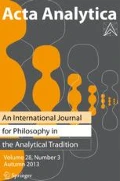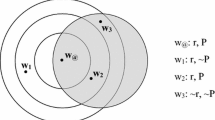Abstract
It is widely thought that if knowledge requires sensitivity, knowledge is not closed because sensitivity is not closed. This paper argues that there is no valid argument from sensitivity failure to non-closure of knowledge. Sensitivity does not imply non-closure of knowledge. Closure considerations cannot be used to adjudicate between safety and sensitivity accounts of knowledge.
Similar content being viewed by others
Notes
One of the problems with the method-relativization of modal knowledge conditions (such as sensitivity and adherence) is that it involves the individuation of belief forming methods which, in turn, involves the infamous generality problem. The generality problem is the problem of categorizing belief forming process-tokens into process-types for the purposes of epistemic evaluation. The crux is that there are indefinitely many ways to categorize belief forming process-tokens into types.
McGinn gives basically the same argument against closure: “The following seems an intuitively correct principle: one can know that p only if one can tell whether p – I can know (e.g.) It is raining outside only if I can tell whether it is raining outside. Let us apply this principle to my putative knowledge that there is a table in front of me and that I am not a brain in a vat. Can I tell whether there is a table there? I think that in the ordinary use of the phrase ‘tell whether,’ what this requires is that I can distinguish there being a table from there being a chair or dog or some such. So, granted that conditions are normal – there is a table there, my eyes are functioning normally, etc. – I can tell whether there is a table there. But can I tell whether I am a brain in a vat? … [W]hat is required for telling whether I am a brain in a vat is that I be able to distinguish my being a brain in a vat from my not being a brain in a vat. But it seems clear that I lack this ability – I cannot tell whether I am a brain in a vat because I have no means of distinguishing being in that condition from not being in that condition” (1984: 543).
This is not Roush’s final analysis but only a first approximation. Note that ‘S knows that p implies q’ in the recursive clause is not analyzed as tracking knowledge, for this would lead to circularity.
We cannot make the problem go away by claiming that entailment is not a kind of implication. Even if entailment isn’t a form of implication there are no close possible worlds where, contrary to fact, p doesn’t entail q.
Necessary truths are not the only ones to cause problems for sensitivity. Contingent truths whose negations are nomologically or metaphysically impossible are just as problematic. Sensitivity needs to be restricted to fully contingent propositions, that is, propositions that are neither logically, nor nomologically, nor metaphysically necessary.
DeRose (1995: 22–3) weakens the sensitivity condition in the following way: S knows that p only if either S sensitively believes that p or, where ~p implies some q and we take it that S knows that ~q, ~p fails to explain how S came falsely to believe that ~q. For a critical discussion of this revised sensitivity condition see Black and Murphy (2007: 55).
Cf. Pritchard 2005: 156, 168; Sosa 2002: 267–9; Weatherson 2004: 378–9; Williamson 2000: 179–82. Instead of method-relativizing the safety condition one can also method-relativize the closure principle. Black (2008: 609) proposes a restriction of the closure principle to the same belief-formation process: If S knows via belief-producing mechanism k that p, and if S knows via k+ (which need not be distinct from k) that p entails q, and if k or k+ will allow S reasonably to believe that q, then S knows that q.
Alspector-Kelly (2011) provides a different argument to the effect that safety violates closure: Is it possible to safely believe p and safely believe that p entails q but unsafely believe q? The belief in q is unsafe only if S believes q and q is false. But if q is false, p must be false as well, for p entails q. So the close not-q world in which S believes q is also a not-p world. Since S’s belief in p is safe, S doesn’t believe p in the not-q world. “The question whether safety implies closure turns, then, on whether the fact that S does not believe p in every nearly world in which q is false implies that S also does not believe q in every such world” (2011: 133). Alspector-Kelly argues that just because S doesn’t believe p in not-q worlds doesn’t mean that S doesn’t believe q in not-q worlds.
References
Alspector-Kelly, M. (2011). Why safety doesn’t save closure. Synthese, 183, 127–142.
Barke, A. (2002). The closure of knowledge in context. Paderborn: Mentis.
Baumann, P. (2011). Epistemic closure. In S. Bernecker & D. Pritchard (Eds.), Routledge companion to epistemology (pp. 597–608). London: Routledge.
Black, T. (2002). A Moorean response to brain-in-a-vat scepticism. Australasian Journal of Philosophy, 80, 148–163.
Black, T. (2008). Solving the problem of easy knowledge. The Philosophical Quarterly, 58, 597–617.
Black, T., & Murphy, P. (2007). In defense of sensitivity. Synthese, 154, 53–71.
Blome-Tillmann, M. (2006). A closer look at closure scepticism. Proceedings of the Aristotelian Society, 106, 383–392.
Brueckner, A. (1985). Skepticism and epistemic closure. Philosophical Topics, 13, 89–117.
Brueckner, A. (1994). The structure of the skeptical argument. Philosophy and Phenomenological Research, 54, 827–835.
Brueckner, A. (2004). Strategies for refuting closure for knowledge. Analysis, 64, 333–335.
De Bruin, B. (2008). Epistemic logic and epistemology. In V. F. Hendricks & D. Pritchard (Eds.), New waves in epistemology (pp. 106–136). Houndsmills: Palgrave Macmillan.
DeRose, K. (1995). Solving the skeptical problem. Philosophical Review, 104, 1–52.
DeRose, K. (2004). Sosa, safety, sensitivity, and skeptical hypotheses. In J. Greco (Ed.), Ernest Sosa and his critics (pp. 22–41). Oxford: Blackwell.
Dretske, F. (1970). Epistemic operators. Journal of Philosophy, 67, 1007–1023.
Dretske, F. (1971). Conclusive reasons. Australasian Journal of Philosophy, 49, 1–22.
Dretske, F. (1981). Knowledge and the flow of information. Cambridge: MIT Press.
Dretske, F. (2005). The case against closure. In M. Steup & E. Sosa (Eds.), Contemporary debates in epistemology (pp. 13–26). Oxford: Blackwell.
Goldman, A. I. (1976). Discrimination and perceptual knowledge. Journal of Philosophy, 73, 771–791.
Hales, S. (1995). Epistemic closure principles. Southern Journal of Philosophy, 33, 185–201.
Hawthorne, J. (2004). Knowledge and lotteries. Oxford: Oxford University Press.
Heller, M. (1999a). Relevant alternatives and closure. Australasian Journal of Philosophy, 77, 196–208.
Heller, M. (1999b). The proper role for contextualism in an anti-luck epistemology. Philosophical Perspectives, 13, 115–129.
Hendricks, F. V., & Symons, J. (2006). Where’s the bridge? Epistemology and epistemic logic. Philosophical Studies, 128, 137–167.
Klein, P. (2004). Closure matters: Academic skepticism and easy knowledge. Philosophical Issues, 14, 165–184.
Kvanvig, J. (2004). Nozickian epistemology and the value of knowledge. Philosophical Issues, 14, 202–218.
Kvanvig, J. (2006). Closure principles. Philosophy Compass, 1(3), 256–267.
Kvanvig, J. (2008). Closure and alternative possibilities. In J. Greco (Ed.), The Oxford handbook of skepticism (pp. 456–483). Oxford: Oxford University Press.
Luper, S. (2003). Indiscernability skepticism. In S. Luper (Ed.), The skeptics (pp. 183–202). Hamshire: Ashgate.
McGinn, C. (1984). The concept of knowledge. Midwest Studies in Philosophy, 9, 529–554.
Miščević, N. (2007). Armchair luck: Apriority, intellection and epistemic luck. Acta Analytica, 22, 48–73.
Murphy, P. (2005). Closure failures for safety. Philosophia (Israel), 33, 331–334.
Murphy, P. (2006). A strategy for assessing closure. Erkenntnis, 65, 365–383.
Nozick, R. (1981). Philosophical explanations. Cambridge: Harvard University Press.
Pritchard, D. (2005). Epistemic luck. Oxford: Clarendon Press.
Pritchard, D. (2007). Knowledge, luck, and lotteries. In V. F. Hendricks & D. H. Pritchard (Eds.), New waves in epistemology (pp. 28–51). London: Palgrave Macmillan.
Pritchard, D. (2009). Safety-based epistemology: Whither now? Journal of Philosophical Research, 34, 33–45.
Radford, C. (1966). Knowledge – by examples. Analysis, 27, 1–11.
Roush, S. (2005). Tracking truth: Knowledge, evidence, and science. Oxford: Oxford University Press.
Sainsbury, M. (1997). Easy possibilities. Philosophy and Phenomenological Research, 57, 907–919.
Sosa, E. (1996). Postscript to ‘proper functionalism and virtue epistemology’. In J. L. Kvanvig (Ed.), Warrant in contemporary epistemology: Essays in honor of plantinga’s theory of knowledge (pp. 271–280). Lanham: Rowman & Littlefield.
Sosa, E. (1999). How to defeat opposition to Moore. Philosophical Perspectives, 13, 141–153.
Sosa, E. (2002). Tracking, competence, and knowledge. In P. Moser (Ed.), Oxford handbook of epistemology (pp. 264–286). New York: Oxford University Press.
Van Benthem, J. (2006). Epistemic logic and epistemology. Philosophical Studies, 128, 49–76.
Vendler, Z. (1972). Res cogitans: An essay in rational psychology. Ithaca: Cornell University Press.
Warfield, T. A. (2004). When epistemic closure does and does not fail: A lesson from the history of epistemology. Analysis, 64, 35–41.
Weatherson, B. (2004). Luminous margins. Australasian Journal of Philosophy, 82, 373–383.
Williamson, T. (2000). Knowledge and its limits. Oxford: Oxford University Press.
Acknowledgement
Earlier drafts of this paper were presented at the 34th International Wittgenstein Symposium in Kirchberg am Wechsel (2011) and the University of Connecticut (2011). Travel expenses related to this project were supported by a UC Irvine Chancellor’s Fellowship. For helpful comments on earlier drafts of this paper I am grateful to Peter Baumann, Paul Bloomfield, Tom Bontly, Fred Dretske, John Greco, Michael Lynch, Lionel Shapiro, Sam Wheeler, and an anonymous referee for this journal.
Author information
Authors and Affiliations
Corresponding author
Rights and permissions
About this article
Cite this article
Bernecker, S. Sensitivity, Safety, and Closure. Acta Anal 27, 367–381 (2012). https://doi.org/10.1007/s12136-011-0137-x
Received:
Accepted:
Published:
Issue Date:
DOI: https://doi.org/10.1007/s12136-011-0137-x



